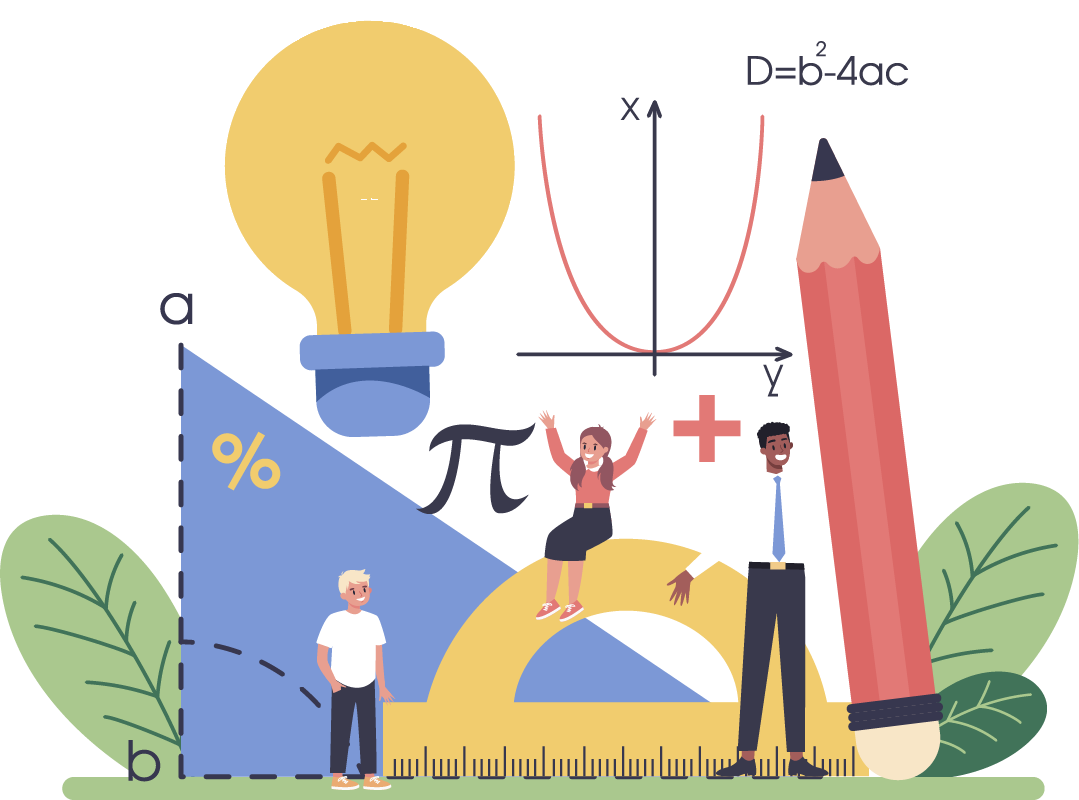In a previous post, we covered how to use the quadratic formula to solve quadratic equations in standard form $$ax^2+bx+c=0$$ Although the quadratic formula will always yield the solution(s) you need, sometimes other methods are more efficient, especially if the quadratic is expressed in another way, such as in vertex form. Other than the quadratic formula, there are three other ways to solving these equations: the square roots method, factoring, and completing the square (which uses the square roots method).
1. Factoring
If the coefficient a in front of x is 1, usually factoring is the most efficient method to go with. The purpose is to turn the quadratic in standard form into x-intercept form so that the roots can be easily identified. For example, take the problem
$$x^2-6x+8=0$$
What we are looking for is two factors that multiply to 8 and add to -6. These will be -2 and -4. So the quadratic in factored form is
$$(x-2)(x-4)=0$$
$$x=2, 4$$
If the coefficient a is not 1, you can use the Diamond Method to factor it. For example, take $2x^2+7x-15=0$. In this problem, $a=2$, $b= 7$, and $c = -15$. Take a and c and multiply them together to get -30. The coefficient b is 7. Now we’re looking for two numbers that multiply to ac (-30) and add or subtract to b (7).
The simplest way to search for those two numbers is to write out the factors of -30 in pairs, starting with 1, as follows:
$$\pm 1, \pm 30$$
$$\pm 2, \pm 15$$
$$\pm 3, \pm 10$$
Here we can see that 10 and -3 will add up to 7, so these are the factors.
Next, split up the x term in $2x^2+7x-15=0$ into those factors:
$$2x^2+10x-3x-15=0$$
Then factor by grouping.
$$2x(x+5) – 3(x+5)=0$$
$$(2x-3)(x+5)=0$$
$x=3/2$ and $-5$.
However, sometimes you may not be able to find integer factors for ac that add up to b, in which case use the quadratic formula or complete the square.

2. Square Roots Method
Whenever a quadratic equation has only $x^2$ terms (and no $x$ terms), the square roots method is most efficient. For example, to solve
$$2x^2 + 4 = x^2 + 20$$
Start by combining the like terms of $x^2$ together on one side, and the constants on the other (by subtracting $x^2$ and then 4 from both sides).
$$2x^2-x^2 + 4 = 20$$
$$x^2 + 4 = 20$$
$$x^2 = 16$$
$$x = \pm4$$
Don’t forget the $\pm$ since both are solutions that will give the positive square number!
Caution – if the last step with $x^2$ equals a negative number (for example $x^2 = -16$, then the equation has no real solutions, although your math class may ask you to include imaginary solutions (which will be $\pm4i$).

3. Completing the Square
Generally, the purpose of completing the square is to turn a quadratic in standard form into vertex form $y=a(x-h)^2+k$, where $(h,k)$ is the vertex of the parabola, since it is the least efficient way of solving an equation. But it can still be used for when the solutions may not be rational numbers. Let’s say we want to solve, by completing the square,
$$3x^2-12x+7=0$$
First, factor out the coefficient in front of $x^2$ and include the $x$ term in parentheses as well:
$$3(x^2-4x) + 7 = 0$$
Next, we want to find a number to add to $(x^2-4x)$ so that it will turn into the binomial squared form $(x-h)^2$. To find it, take the b coefficient in front of the $x$ term, divide by 2, and square it – in this case, the coefficient is -4.
$$(\frac{-4}{2})^2 = 4$$.
Add the 4 inside the parentheses
$$3(x^2-4x+4) + 7 = 0$$
Because we’ve effectively added 3$\times$4 = 12 to the left side of the equation, we have to subtract 12 in order to keep the original equation!
$$3(x^2-4x+4)+7-12 = 0$$
$$3(x^2-4x+4)-5 = 0$$
Now the $(x^2-4x+4)$ can be factored into $(x-2)^2$.
$$3(x-2)^2-5 = 0$$
From here, use the square roots method to solve.
$$3(x-2)^2=5$$
$$(x-2)^2=\frac{5}{3}$$
$$x-2=\pm\sqrt{\frac{5}{3}}$$
$$x=2\pm\sqrt{\frac{5}{3}}$$
The two solutions are irrational, but roughly 3.29 and 0.71.
If you find yourself struggling with quadratic equations or any other aspect of algebra, don’t hesitate to reach out for help. Our Algebra 1 and Algebra 2 tutors are here to guide you through your math class, providing personalized support tailored to your learning style and pace. Ready to take your algebra skills to the next level? Schedule a free consultation with us today!

Yuki is a skilled educator with a degree in Chemistry from Carnegie Mellon University. She discovered her passion for teaching math after tutoring at an after-school program. With five years of tutoring experience, Yuki creates a supportive learning environment for students. Outside of tutoring, she enjoys trying new cuisines and playing piano.

